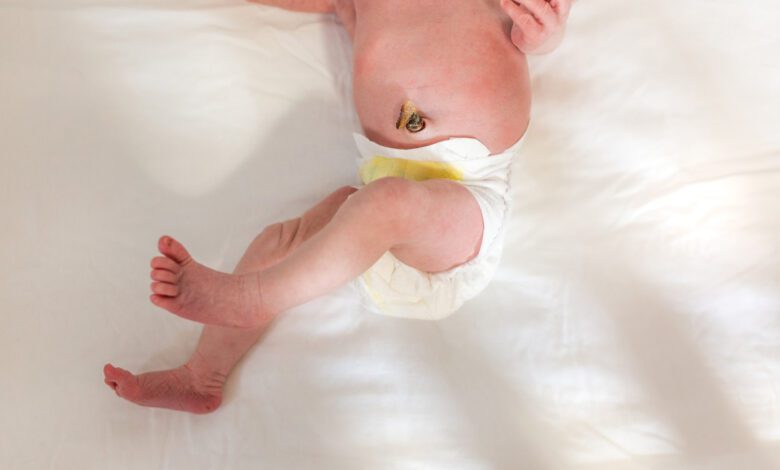What Happens to Baby’s Umbilical Cord After Birth?

You’ve been dreaming of this moment for the past 40 weeks (give or take)—your baby is finally here! But after the labor of labor and before you bask in newborn bliss, there’s one more piece of the puzzle to contend with: the baby’s belly button.
The umbilical cord serves as a lifeline in the womb, so special attention is in order as the baby transitions after birth to their independent self. Because of this, there’s a lot new parents need to know about clamping, cutting, and caring for the umbilical cord after birth—from the umbilical cord stump to the umbilicus (aka the baby’s belly button).
Rope of Life
At eight months or so, the umbilical cord (fully developed around seven weeks gestation) carries nutrients and oxygen from you to your baby and delivers deoxygenated blood and waste back to the placenta. In full-term, it contains two umbilical arteries and an umbilical vein. Usually, it’s around 20 inches long.
After delivery, the blood vessels of the cord are clamped and squeezed prevent blood flow in both directions. This can happen just after birth, separating the cord from the placenta, as has been standard care in hospital births for decades. According to American College of Obstetricians and Gynecologists (ACOG), it is best practice for doctors to clamp the cord between 30 and 60 seconds after birth.
Your doctor or midwife will use two (metal or plastic) clamps to reduce or stop the bleeding, and then your partner or caregiver may cut the umbilical cord between the clamps. Neither the birth parent nor the baby feels any pain while cutting the cord because, like your ears, it no nerves.
Delayed Clamping
Although most Western doctors still clamp the cord within a minute of birth, health care providers are paying attention to research that suggests baby benefits from delayed cord clamping, or waiting until the cord stops pulsing to clamp. Research shows that the umbilical vein closes slightly more than the umbilical arteries, allowing blood to return to the baby in the first few minutes of life, which can offer a healthy boost.
Mark Sloan, MD, MPH, pediatrician and author of Birth Day: A Pediatrician Explores the Science, History and Miracle of Birth, wrote about the benefits of delayed cord clamping. “At term, about one-third of the fetus’s blood supply resides in the placenta. During the course of labor and delivery, most of that blood is transferred from the placenta to the newborn, driven by the force of contractions. of the uterus,” he explained. “That transfusion continues after the moment of birth; if not interrupted for one to three minutes, the placenta will deliver about three additional ounces of blood to the newborn.”
Studies have shown that a small amount of extra blood can benefit the baby in many ways, including giving them a healthy supply of iron up to six monthswhich is important to growth and development of the baby’s brain.
If you are interested in waiting to have the baby’s cord clamped, talk to your healthcare provider about including this request as part of your birth plan. “Most physicians will take a [parent’s] desire, and as the benefits of delayed clamping become better known, many hospitals are changing to make delayed cord clamping standard care in their labor and delivery units,” said Dr. Sloan.
Cord Blood Banking
If you choose collect cord blood at the bank for your family or to donate, this happens between the time the cord is cut and the placenta is delivered. Your health care provider takes the cord blood sample from the end of the umbilical cord, which is attached to the placenta, while you and your baby are bonding and not disturbed.
After the cord blood is collected in a special bag, it is processed in a lab before being stored in a facility (this can be public or private, depending on your choice). This blood can later be used to treat certain diseases, including helping to reverse the side effects of cancer treatment on the immune system.
Umbilical Cord Stump Care
Regardless of whether you delay clamping, once cut, there will be a short cord stump left. According to American Academy of Pediatrics (AAP), A baby’s umbilical cord stump falls off within a few weeks after birth and should heal without complications if dry cord care is performed and allowed to fall on its own—no pulling or picking.
Keep it clean and dry while it heals (no rubbing alcohol, which can kill helpful bacteria), and sponge bath your baby during this time instead of putting them in a tub of water. Dress the baby in loose clothing, and fold their diaper down or cut an opening so it doesn’t rub against the stump, allowing air to dry it.
It is normal to see a few drops of blood in the baby’s diaper after the stump falls out (similar to how a scab bleeds a little). However, the AAP notes that if the cord area has a yellowish discharge, you notice redness or swelling around the base of the cord stump, a pink moist bump appears (granuloma), or the baby cries when you touch the umbilical cord stump or the skin around it, they can be signs of an infection in the navel. If the symptoms do not go away on their own or the stump does not fall out after three weeks, contact your pediatrician immediately.
It’s truly incredible how much the umbilical cord can do for your baby as it grows and develops in the womb. And even the aftercare needed after birth is worth it—because your baby will be left with an adorable, tiny belly button as a result (which is also a reminder of how amazing your body works).





